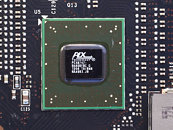- Joined
- Oct 9, 2007
- Messages
- 47,617 (7.44/day)
- Location
- Dublin, Ireland
| System Name | RBMK-1000 |
|---|---|
| Processor | AMD Ryzen 7 5700G |
| Motherboard | Gigabyte B550 AORUS Elite V2 |
| Cooling | DeepCool Gammax L240 V2 |
| Memory | 2x 16GB DDR4-3200 |
| Video Card(s) | Galax RTX 4070 Ti EX |
| Storage | Samsung 990 1TB |
| Display(s) | BenQ 1440p 60 Hz 27-inch |
| Case | Corsair Carbide 100R |
| Audio Device(s) | ASUS SupremeFX S1220A |
| Power Supply | Cooler Master MWE Gold 650W |
| Mouse | ASUS ROG Strix Impact |
| Keyboard | Gamdias Hermes E2 |
| Software | Windows 11 Pro |
An increasing number of high-end graphics cards and motherboards are relying on PCI-Express bridge chips to expand the PCI-Express lane budgets, no thanks to the puny number of PCI-Express lanes today's mainstream computing platforms come with. Following the transition to PCI-Express Gen 3.0, with Intel's new platforms (Ivy Bridge and Sandy Bridge-E HEDT), there is a demand for Gen 3.0-compliant PCIe switching hardware, especially x48 bridge chips (which take in a PCI-Express x16 link, giving out two x16 links or four x8 links). Such chips are used on high-end motherboards to expand the number of PCIe slots, and on dual-GPU graphics cards.
It appears like NVIDIA does not have a PCIe Gen 3.0-compliant bridge chip of its own, and so the only company with one, is PLX Technology, with its PEX8747. The chip has been used on a variety of high-end motherboards, and NVIDIA's GeForce GTX 690 dual-GPU graphics card. PLX reportedly saw high demand, which resulted in several companies bagging initial allocations of the chip, leaving others out to dry, with the part being listed as out-of-stock by its maker. Newer clients of the chip will have to wait until PLX undertakes the next big production cycle, to get their allocations of the chip.

Casualties of shortage of the PEX8747 include the launch of AMD's ambitious Radeon HD 7990 dual-GPU graphics card, the various "HD 7970 X2" graphics cards, and high-end motherboards (eg: ASUS' Maximus V Extreme). NVIDIA's GTX 690 itself isn't readily found, either, and we are hard pressed to buy the "high-demand" argument that has been used to explain GTX 680 shortages, and to good effect, considering the GTX 690's scorching $999-$1299 end-user price.
At Computex, we spoke with some of the graphics card vendors with so-called HD 7970 X2 models in the works. We learned through our conversations that some of them are hit by the shortage of PEX8747, which destabilized their product launch schedules, and that they are looking for "alternatives." These could include PCI-Express Gen 2.0 switches, which could hurt the products' specification sheets unless the companies balance it with [relatively] attractive pricing (at their expense of their margins).
If AMD is banking on dual-GPU graphics cards such as the HD 7990 to restore competitiveness of its high-end lineup, now would be a good time to invest in development of a PCI-Express 3.0 bridge chip of its own. We know it has the chops to do so, being a motherboard chipset designer. The chip could then be implemented on upcoming, as well as future generations of dual-GPU Radeon graphics cards.
With inputs from Hardware.fr.
View at TechPowerUp Main Site
It appears like NVIDIA does not have a PCIe Gen 3.0-compliant bridge chip of its own, and so the only company with one, is PLX Technology, with its PEX8747. The chip has been used on a variety of high-end motherboards, and NVIDIA's GeForce GTX 690 dual-GPU graphics card. PLX reportedly saw high demand, which resulted in several companies bagging initial allocations of the chip, leaving others out to dry, with the part being listed as out-of-stock by its maker. Newer clients of the chip will have to wait until PLX undertakes the next big production cycle, to get their allocations of the chip.

Casualties of shortage of the PEX8747 include the launch of AMD's ambitious Radeon HD 7990 dual-GPU graphics card, the various "HD 7970 X2" graphics cards, and high-end motherboards (eg: ASUS' Maximus V Extreme). NVIDIA's GTX 690 itself isn't readily found, either, and we are hard pressed to buy the "high-demand" argument that has been used to explain GTX 680 shortages, and to good effect, considering the GTX 690's scorching $999-$1299 end-user price.
At Computex, we spoke with some of the graphics card vendors with so-called HD 7970 X2 models in the works. We learned through our conversations that some of them are hit by the shortage of PEX8747, which destabilized their product launch schedules, and that they are looking for "alternatives." These could include PCI-Express Gen 2.0 switches, which could hurt the products' specification sheets unless the companies balance it with [relatively] attractive pricing (at their expense of their margins).
If AMD is banking on dual-GPU graphics cards such as the HD 7990 to restore competitiveness of its high-end lineup, now would be a good time to invest in development of a PCI-Express 3.0 bridge chip of its own. We know it has the chops to do so, being a motherboard chipset designer. The chip could then be implemented on upcoming, as well as future generations of dual-GPU Radeon graphics cards.
With inputs from Hardware.fr.
View at TechPowerUp Main Site
Last edited:







 My/our purchase $$$ is NOT your R & D $$$. R & D should be done/completed BEFORE release to public
My/our purchase $$$ is NOT your R & D $$$. R & D should be done/completed BEFORE release to public 

